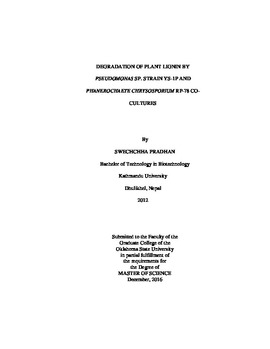| dc.contributor.advisor | Fathepure, Babu Z. | |
| dc.contributor.author | Pradhan, Swechchha | |
| dc.date.accessioned | 2019-08-19T13:55:03Z | |
| dc.date.available | 2019-08-19T13:55:03Z | |
| dc.date.issued | 2016-12-01 | |
| dc.identifier.uri | https://hdl.handle.net/11244/321145 | |
| dc.description.abstract | Delignification is a critical step in the bioconversion of lignocellulosic biomass into useful monomers. Fungi and bacteria both have evolved pathways to degrade lignin and are known to play active roles in decomposition of plant biomass. However, little efforts have been made to study them together as an integrated microbial system. There is limited knowledge about what specific roles they play and what kind of interactions they have during the decomposition process. The major focus of this research is to study lignin degradation using Pseudomonas sp. strain YS-1p (bacteria) and Phanerochaete chrysosporium RP-78 (fungi) when inoculated as individual cultures as well as in co-cultures in mineral salts medium supplemented with plant biomass: sugarcane bagasse and sorghum bagasse. Flasks were inoculated with strain RP-78 (F) and strain YS-1p (B) at various fungal-to-bacterial ratios including 0:1, 1:0, 1:1, 1:10 and 1:50, respectively. Flasks were sacrificed periodically and monitored for population dynamics. Culture supernatant was assayed for major lignin degrading enzymes including lignin peroxidase, dyp peroxidase and laccase. Additionally, extracellular enzymes were concentrated and subjected to 1-D PAGE-LC-MS/MS for proteome analysis, while recovered plant biomass was used for Py-GC/MS analysis. Our results show that Pseudomonas grew best in co-cultures with P. chrysosporium whereas the growth of latter was suppressed in the presence of bacteria. This also affected their abilities to produce extracellular enzymes involved in lignocellulose degradation as shown by our results of proteome analysis. Most of the enzymes involved in degradation of lignin, cellulose and hemicellulose were produced by the fungi, while the bacteria produced few enzymes at low levels. This suggests that bacteria were able to derive benefit from fungal enzymes for accessing degradation products and promoting their growth without contributing as much to the degradation process. Enzyme activities of lignin degrading enzymes showed that the two peroxidases: Lip and Dyp were expressed maximum in co-cultures while laccase was expressed in highest amounts in bacterial monocultures. Furthermore, analysis of plant biomass by Py-GC/MS revealed that microbial pretreatment altered the composition of lignocellulose in plant biomass with plant biomass showing significant decrease in lignin derivatives than in untreated controls. | |
| dc.format | application/pdf | |
| dc.language | en_US | |
| dc.rights | Copyright is held by the author who has granted the Oklahoma State University Library the non-exclusive right to share this material in its institutional repository. Contact Digital Library Services at lib-dls@okstate.edu or 405-744-9161 for the permission policy on the use, reproduction or distribution of this material. | |
| dc.title | Degradation of Plant Lignin by Pseudomonas sp. Strain YS-1p And Phanerochaete chrysosposium RP-78 Co-Cultures | |
| dc.contributor.committeeMember | Prade, Rolf A. | |
| dc.contributor.committeeMember | Elshahed, Mostafa S. | |
| dc.contributor.committeeMember | Mort, Andrew J. | |
| osu.filename | Pradhan_okstate_0664M_14935.pdf | |
| osu.accesstype | Open Access | |
| dc.description.department | Microbiology, Cell and Molecular Biology | |
| dc.type.genre | Thesis | |
| dc.type.material | Text | |
